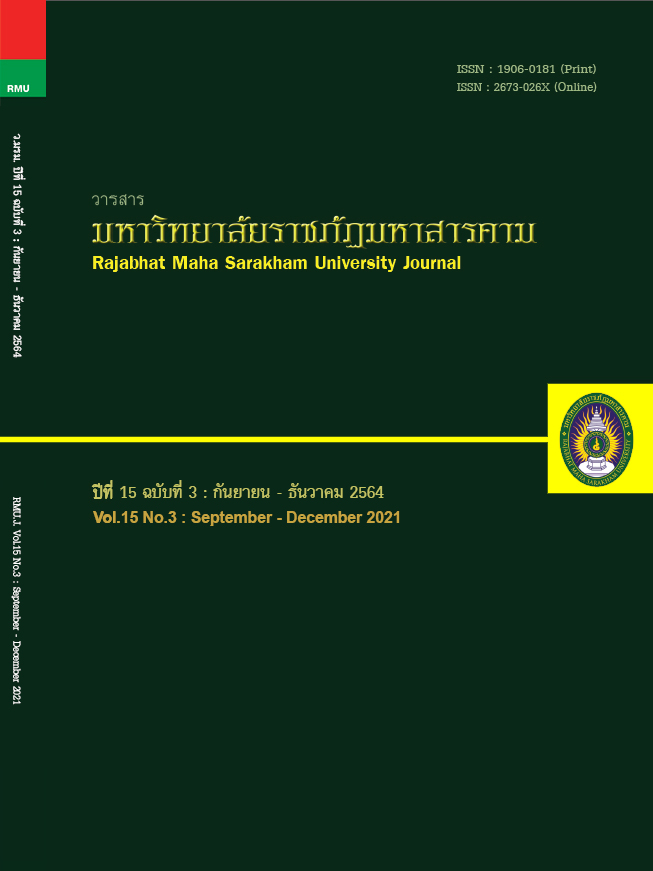การเปรียบเทียบการจัดกิจกรรมการเรียนรู้ทางคณิตศาสตร์ระหว่างการจัดกิจกรรมการเรียนรู้ตามแนวคิดทฤษฎีคอนสตรัคติวิตส์กับแบบปกติ เรื่องตรรกศาสตร์ ชั้นมัธยมศึกษาปีที่ 4
Main Article Content
บทคัดย่อ
การวิจัยนี้มีความมุ่งหมายเพื่อพัฒนาแผนการจัดกิจกรรมการเรียนรู้คณิตศาสตร์ตามแนวคิดทฤษฎีคอนสตรัคติวิตส์เรื่องตรรกศาสตร์ชั้นมัธยมศึกษาปีที่ 4 ให้มีประสิทธิภาพ ตามเกณฑ์ 75/75 ศึกษาดัชนีประสิทธิผลของแผนการจัดกิจกรรมการเรียนรู้คณิตศาสตร์ตามแนวคิดทฤษฎีคอนสตรัคติวิตส์ เรื่องตรรกศาสตร์ ชั้นมัธยมศึกษาปีที่ 4 เพื่อเปรียบเทียบผลสัมฤทธิ์ทางการเรียนของนักเรียนที่เรียนด้วยแผนการจัดกิจกรรมการเรียนรู้ตามแนวคิดทฤษฎีคอนสตรัคติวิตส์กับแบบปกติ เรื่องตรรกศาสตร์ ชั้นมัธยมศึกษาปีที่ 4 และเพื่อเปรียบเทียบความสามารถในการคิดวิเคราะห์ของนักเรียนที่เรียนด้วยแผนการจัดการเรียนรู้ตามแนวคิดทฤษฎีคอนสตรัคติวิตส์กับแบบปกติ เรื่องตรรกศาสตร์ ชั้นมัธยมศึกษาปีที่ 4 กลุ่มตัวอย่าง ได้แก่ นักเรียนชั้นมัธยมศึกษาปีที่ 4 จำนวน 2 ห้องเรียน ห้องเรียนละ 36 คน ได้มาโดยวิธีการสุ่มแบบกลุ่ม (Cluster Random Sampling) เครื่องมือที่ใช้ในการวิจัย ได้แก่ แผนการจัดกิจกรรมการเรียนรู้คณิตศาสตร์ตามแนวคิดทฤษฎีคอนสตรัคติวิตส์ที่และแผนการจัดกิจกรรมการเรียนรู้แบบปกติ อย่างละ 18 แผน แบบทดสอบวัดผลสัมฤทธิ์การเรียนรู้ จำนวน 30 ข้อ มีค่าอำนาจจำแนกรายข้อ ตั้งแต่ 0.26-0.99 ค่าความยากตั้งแต่ 0.22-0.78 และค่าความเชื่อมั่นทั้งฉบับ 0.84 และแบบทดสอบวัดความสามารถในการคิดวิเคราะห์ จำนวน 6 ข้อ มีค่าอำนาจจำแนกรายข้อ ตั้งแต่ 0.36-0.52 ค่าความยากตั้งแต่ 0.32–0.70 และค่าความเชื่อมั่นทั้งฉบับ 0.58 สถิติที่ใช้ในการวิเคราะห์ข้อมูล ได้แก่ ค่าเฉลี่ย ส่วนเบี่ยงเบนมาตรฐาน ร้อยละ และทดสอบสมมติฐานโดยใช้ t-test (Independent Samples)
ผลการวิจัยปรากฏดังนี้ว่า ประสิทธิภาพของแผนการจัดการเรียนรู้ (E1/E2) ของการเรียนรู้คณิตศาสตร์ตามแนวคิดทฤษฎีคอนสตรัคติวิตส์ เท่ากับ 78.07/76.48ค่าดัชนีประสิทธิผลเท่ากับ 0.6308 คิดเป็นร้อยละ 63.08ผลสัมฤทธิ์ทางการเรียนรู้คณิตศาสตร์ เรื่องตรรกศาสตร์ ชั้นมัธยมศึกษาปีที่ 4 โดยการจัดกิจกรรมการเรียนรู้ตามแนวคิดทฤษฎีคอนสตรัคติวิตส์สูงกว่าการจัดกิจกรรมการเรียนรู้แบบปกติ อย่างมีนัยสำคัญที่ระดับ .05 และผลการทดสอบความสามารถในการคิดวิเคราะห์หลังการจัดกิจกรรมการเรียนรู้ตามแนวคิดทฤษฎีคอนสตรัคติวิตส์สูงกว่าการจัดกิจกรรมการเรียนรู้แบบปกติ อย่างมีนัยสำคัญที่ระดับ .05
Article Details
1. บทความที่ลงตีพิมพ์ทุกเรื่องได้รับการตรวจทางวิชาการโดยผู้ประเมินอิสระ ผู้ทรงคุณวุฒิ (Peer Review) สาขาที่เกี่ยวข้อง อย่างน้อย 3 ท่าน ในรูปแบบ Double blind review
2. ข้อคิดเห็นใด ๆ ของบทความที่ลงตีพิมพ์ในวารสารมหาวิทยาลัยราชภัฏมหาสารคาม นี้เป็นของผู้เขียน คณะผู้จัดทำวารสารไม่จำเป็นต้องเห็นด้วย
3. กองบรรณาธิการวารสารมหาวิทยาลัยราชภัฏมหาสารคาม ไม่สงวนสิทธิ์การคัดลอกแต่ให้อ้างอิงแสดงที่มา
เอกสารอ้างอิง
จิราภรณ์ ศิริทวี. (2541). เทคนิคการจัดกิจกรรมให้นักเรียนสร้างองค์ความรู้(Constructivism).วารสารวิชาการ,1(9),37-52.
จามรี สมานชาติ. (2554). การเปรียบเทียบผลสัมฤทธิ์ทางการเรียนและเจตคติต่อคณิตศาสตร์ของนักเรียนระดับชั้นมัธยมศึกษาปีที่ 3 ที่เรียนด้วยการจัดการเรียนการสอนเรื่อง ความน่าจะเป็นตามแนวคิดทฤษฎีคอนสตรัคติวิซึมกับทฤษฎีพหุปัญญา.วารสารศึกษาศาสตร์ มหาวิทยาลัยมหาสารคาม.
ชัยวัฒน์สุทธิรัตน์. (2552). 80 นวัตกรรมการจัดการเรียนรู้ที่เน้นผู้เรียนเป็นสำคัญ.กรุงเทพฯ:แดเน็กซ์อินเตอร์คอร์ปอเรชั่น.
ธรรมภรณ์ปักกาเร. (2553).การเปรียบเทียบผลการเรียนรู้เรื่องลำดับและอนุกรมกลุ่มสาระการเรียนรู้คณิตศาสตร์ชั้นมัธยมศึกษาปีที่ 5 ด้วยการจัดกิจกรรมการเรียนรู้ตามแนวทฤษฎีคอนสตรัคติวิสต์กับการจัดกิจกรรมการเรียนรู้แบบ TAI(วิทยานิพนธ์กศ.ม.). มหาสารคาม: มหาวิทยาลัยมหาสารคาม.ธิดารัตน์พลหนองคูณ. (ม.ป.ป.).การพัฒนากิจกรรมการเรียนการสอนคณิตศาสตร์ตามแนวทฤษฎีคอนสตรัคติวิสต์โดยใช้การเรียนรู้แบบร่วมมือรูปแบบ STAD เรื่องพื้นที่ผิวและปริมาตรชั้นมัธยมศึกษาปีที่ 3. วารสารวิชาการหลักสูตรและการสอน มหาวิทยาลัยราชภัฏสกลนคร.
ปิยะพร นิตยารส. (2562). การพัฒนาการจัดการเรียนรู้คณิตศาสตร์ตามแนวคิดทฤษฎีคอนสตรัคติวิสต์ที่ส่งเสริมทักษะการแก้ปัญหาเรื่อง อสมการ ชั้นมัธยมศึกษาปีที่ 3. วารสารการวัดผลการศึกษามหาวิทยาลัยมหาสารคาม.
ภัชญาดา พรมศร. (2561). การพัฒนาบทเรียนบนเว็บตามแนวทฤษฎีคอนตรัคติวิสต์ที่ส่งเสริมทักษะการคิดวิเคราะห์ เรื่อง คอมพิวเตอร์ในชีวิตประจำวัน ของนักเรียนชั้นมัธยมศึกษาปีที่ 1.วารสารบัณฑิตวิทยาลัยพิชญทรรศน์,13 (2),137-146, กรกฏาคม-ธันวาคม
ลักขณา สริวัฒน์.(2549).จิตวิทยาในชีวิตประจำวัน(พิมพ์ครั้งที่ 2).กรุงเทพฯ: โอเดียนสโตร์.
วิภาวรรณ สุขสุวรรณ. (2560).การพัฒนากิจกรรมการเรียนรู้ตามแนวคอนสตรัคติวิสต์ที่ส่งเสริมความสามารถในการคิดวิเคราะห์ เรื่อง สมการเชิงเส้นตัวแปรเดียว สำหรับนักเรียนชั้นมัธยมศึกษาปีที่ 1.วารสารศึกษาศาสตร์มหาวิทยาลัยนเรศวร.
สถาบันการทดสอบทางการศึกษาแห่งชาติ.(2562).การประกันคุณภาพการศึกษา.กรุงเทพฯ: โครงการประกันคุณภาพการศึกษา.
สำนักงานคณะกรรมการการศึกษาขั้นพื้นฐาน.(2552).แนวปฏิบัติการวัดและประเมินผลการเรียนรู้ตามหลักสูตรแกนกลางการศึกษาขั้นพื้นฐานพุทธศักราช 2551.
สุมาลี ชัยเจริญ. (2547). การพัฒนากระบวนการสร้างความรู้ของผู้เรียนตามแนวคอนสตรัคติวิตส์โดยความร่วมมือของครูกับนักการศึกษา. คณะกรรมการสภาวิจัยแห่งชาติ.
สุมาลี ชัยเจริญ. (2554).เทคโนโลยีการศึกษา: หลักการทฤษฎี สู่การปฏิบัติ(พิมพ์ครั้งที่ 2). ขอนแก่น:โรงพิมพ์คลังนานาวิทยา.
Campbell Tyler.(2009). Reform, Moderate, or Traditional Teaching Strategies and Their Effect on Student Achievement inMathematics.Dissertation Abstracts International.
Lane, M. Lynne.(2004). The Effects Staff Development on Student Achievement.DissertationAbstracts International, 64(7), 2451-A.
Sutthirat.(2010).Questioning techniques for developing thinking.Nonthaburi:SahamitrPrinting & Publishing.
Woolfolk, A. (2010).Educational Psychology.Columbus, OH’.


